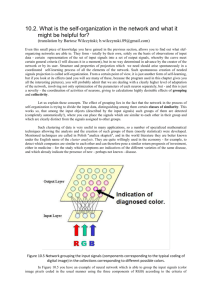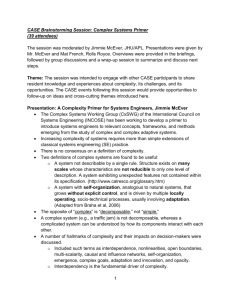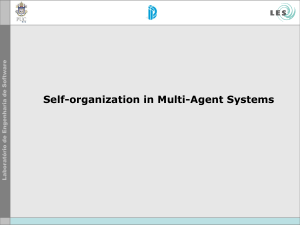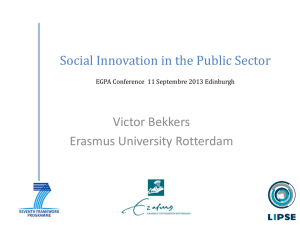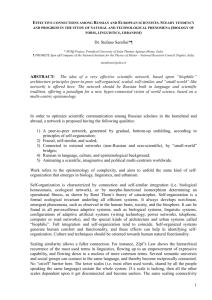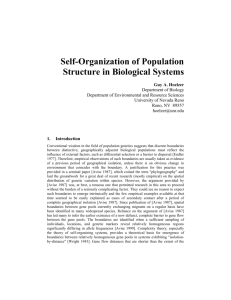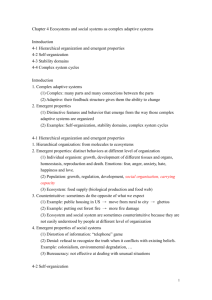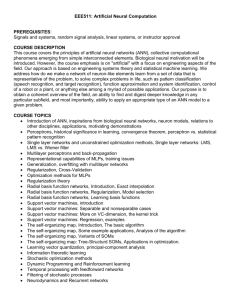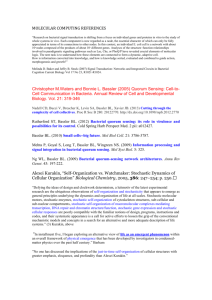Self-organizing Systems
advertisement
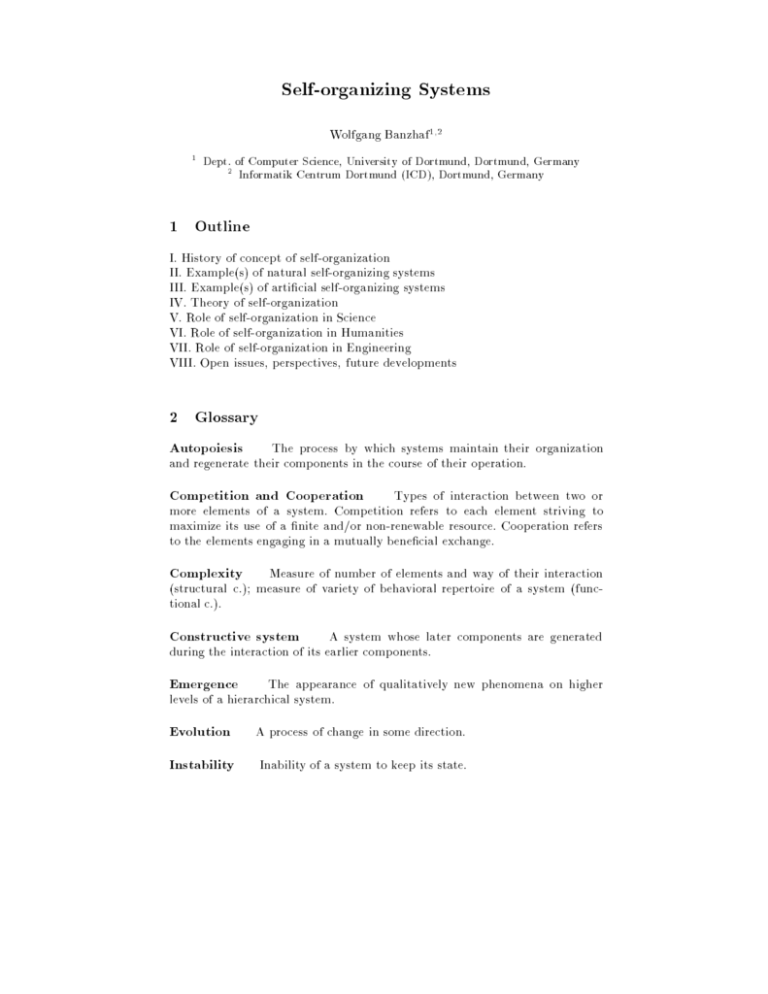
Self-organizing Systems Wolfgang Banzhaf1 2 ; 1 Dept. of Computer Science, University of Dortmund, Dortmund, Germany 2 Informatik Centrum Dortmund (ICD), Dortmund, Germany 1 Outline I. History of concept of self-organization II. Example(s) of natural self-organizing systems III. Example(s) of articial self-organizing systems IV. Theory of self-organization V. Role of self-organization in Science VI. Role of self-organization in Humanities VII. Role of self-organization in Engineering VIII. Open issues, perspectives, future developments 2 Glossary Autopoiesis The process by which systems maintain their organization and regenerate their components in the course of their operation. Competition and Cooperation Types of interaction between two or more elements of a system. Competition refers to each element striving to maximize its use of a nite and/or non-renewable resource. Cooperation refers to the elements engaging in a mutually benecial exchange. Complexity Measure of number of elements and way of their interaction (structural c.); measure of variety of behavioral repertoire of a system (functional c.). Constructive system A system whose later components are generated during the interaction of its earlier components. Emergence The appearance of qualitatively new phenomena on higher levels of a hierarchical system. Evolution A process of change in some direction. Instability Inability of a system to keep its state. Mode Macroscopic behavior of a system caused by the interaction of its microscopic parts via long-range correlations. Non-equilibrium System state with inow of matter, energy and/or information causing it to stay away from its most probable state under the hypothetical condition of isolation. Phase Transition suddenly. A point at which the appearance of a system changes Resilience Measure of a system's ability to remain within a domain of stability in response to uctuations of the system by a disturbance, and the ability of the system to return to that stable domain having once left. Self-organized Criticality The ability of a system to evolve in such a way as to approach a critical point and then maintain itself at that point. 3 Opening The term Self-organizing Systems refers to a class of systems that are able to change their internal structure and their function in response to external circumstances. By self-organization it is understood that elements of a system are able to manipulate or organize other elements of the same system in a way that stabilizes either structure or function of the whole against external uctuations. Over the last decades a variety of features have been identied as typical for self-organizing systems. Not all of these features are present in all systems able to self-organize. Self-organizing systems are dynamic, non-deterministic, open, exist far from equilibrium and sometimes employ autocatalytic amplication of uctuations. Often, they are characterized by multiple time-scales of their internal and/or external interactions, they possess a hierarchy of structural and/or functional levels and they are able to react to external input in a variety of ways. Many self-organizing systems are non-teleological, i.e. they do not have a specic purpose except their own existence. As a consequence, self-maintenance is an important function of many self-organizing systems. Most of these systems are complex and use reduncancy to achieve resilience against external pertubation tendencies. Self-organizing systems have been discovered in nature, both in the non-living (galaxies, stars) and the living world (cells, organisms, ecosystems), they have been found in man-made systems (societies, economies), and they have been identied in the world of ideas (world views, scientic believes, norm systems). 4 History of the concept of self-organization 4.1 Early History The concept of self-organization can be traced back to at least two sources: Western philosophy inuenced heavily by Greek thinking; and eastern philosophy, centered around the process thinking of Bhuddism. From both of these sources ideas have been generated which resound with the modern way of thinking about self-organization although the word itself had never been used. On wondering about the origin of the world Greek and Roman atomists from Democritus to Epicurus argued that world order arose from chance collisions of particles. First, the cosmos (from Greek kosmos = the ordered) did not exist but chaos instead (from Greek chaos = the disordered). In modern times chaos theory has taken up this topic again, with deep connections to ideas about selforganization and the origin of order in the universe. The Bhuddist way of thinking, on the other hand, was fundamentally processoriented. Things are considered not to be in static existence, but rather are thought to be generated and maintained by proper processes. The emphasis on processes is reminescent of self-organizing systems whose structure is determined by proper processes of internal and external interactions. 4.2 The rst use of the term Work on General Systems Theory (von Bertalany) and Cybernetics (Wiener) paved the way for the idea of self-organization. The concept of a self-organizing system was introduced by Ashby in 1947. In the 1950s a self-organizing system was considered to be a system which changes its basic structure as a function of its experience and environment. The term was used by Farley and Clark in 1954 to describe learning and adaptation mechanisms. Ashby, in 1960, redened a self-organizing system to include the environment with the system proper. Von Foerster argued, also in 1960, that a dynamical system which is self-organizing possesses some stable structures (eigenvalues, attractor states) which he later termed eigenbehavior. 4.3 Further developments This notion was further developed by Haken in 1977 who termed the global cooperation of elements of a dynamical system in the attractor state which emerges from the interaction between these elements and the environment selforganization. Both Haken and Kauman (1993) argued for a deep connection between self-organization and selection. Kauman in particular emphasized the role of constraints on the direction of evolution caused by self-organization. Already in the 1970s, however, ideas branched out into dierent directions. One branch of the development of the idea deepened the relation to studies of learning and adaptation (Conrad, Kohonen), another branch studied processes of self-organization in systems far from equilibrium (Prigogine, Haken). Chaos theory (Thom, Mandelbrot) was the line of inquiry into nonlinear systems in mathematics, whereas autopoiesis and self-maintenance where at center stage in biology (Eigen, Rosen) neurophysiology and cognitive science (von Foerster, Maturana, Varela). In recent years, self-organizing systems have assumed center stage in the natural sciences, and the humanities. Engineering is beginning to see the usability of the concept in connection with the approach of nano-scale applications. 5 Examples of natural self-organizing systems Classical examples of natural self-organizing systems are the formation of Benard convection cells in non-equilibrium thermodynamics, the generation of laser light in non-linear optics and the Belousov-Zhabotinsky reaction in chemistry. We shall look at the former two in the following subsections and, in order to reect more recent developments, add the non-classical example of formation of stars in a galaxy. 5.1 Rayleigh-Benard Convection Rayleigh-Benard convection is the coordinated movement of a uid which is conned between two thermally conducting plates, and is heated from below to produce a temperature dierence. An uncoordinated movement of uid particles which allows energy transfer between lower and upper plates is substituted by a coordinated movement above a certain temperature gradient. Rayleigh-Benard convection forms convection rolls (see Figure 1) and allows a much more ecient energy transport between the plates. In order for convection to occur, small uctuations of hot uid which begin to rise to the top of the uid layer grow in size through amplicationprocesses. If the temperature dierence is above a certain threshold, an organized ow resembling overturning cylinders is formed. If the temperature dierence is raised further, the uid rises very quickly, and a transition from laminar to turbulent ow of the uid may occur. It can be said that the system, by generating a more ecient energy transport through convection, tends to resist the external perturbation and to try to return back to the equilibrium state. Fig. 1. Cross-sectional view of cell illustrating convection rolls. 5.2 The Generation of Laser light The generation of laser light lies, strictly speaking, at the border between a natural system and an articial system. It uses an articially evoked natural process to generate a type of light, that is otherwise only visible in certain very specic astronomical phenomena (, > masers). A sketch of a solid state laser is shown in Figure 2, left. A rod of material which consists of specic atoms is framed by two mirrors at each side, one of which is half-transparent. The material is called active because it can be excited from the outside and will then emit light of a characteristic wavelength. Excitation of atoms is achieved by pumping energy into the system from the open side. The atoms in the active medium absorb the pumping energy and transform it into light. The emission process lasts typically for 10,8 seconds and results in an excited light wave of length in meters (see Figure 2, middle). The mirrors select for certain wavelengths and lightwaves emitted in the axial direction. These waves are reected several times between the mirrors and stay longer in the laser zone, while all other waves leave the cavity quickly and disappear. The reected part causes other excited atoms to emit light of the same wavelength and phase. This results in an amplication of the originally spontaneous emission of light from atoms without phase correlation (see Figure 2, right). As in the example with the Rayleigh-Bernard convection cells, after a certain threshold of pumping energy is passed, the system starts to exhibit qualitatively dierent behavior: As a result of the dominating induced emission the system emits coherent light waves of exactly the same phase, emitting light at a much higher eciency than was otherwise possible with incoherent light waves below the threshold. Fig. 2. Laser device (reproduced from Haken, [5]). 5.3 Non-classical example: A galaxy as a self-organizing system Since the 1980s it became clear that the galaxies of our universe are another instance of self-organizing systems. Particularly the star formation process in present-day galaxies follows the typical principles of self-organization phenomena. A galaxy may be considered to be an open non-equilibrium system with non-linear process dynamics. It thus exhibits typical coherent behavior of galactic scale by long range star formation waves travelling across its extension. The mechanism is roughly sketched as follows: The interstellar medium contains at least three distinguishable components: 1. hot coronal gas (H II, mostly hydrogen and helium with a temperature of T 105 , 106 K ), 2. cool atomic gas (H I, T 100K ), and 3. cool clouds of molecular gas and dust (T 10 , 100K ). H I and molecular clouds lie embedded in coronal gas and form cool clumps or laments. The presence of molecules improves the eciency of cooling of a cloud. The loss of energy of the cloud leads to gravitational contraction without a raise in temperature. Molecular synthesis can then be facilitated and H2 synthesis will run at higher rate. Molecular production in interstellar clouds thus sets up a positive feedback loop leading to the amplication of molecular production. Provided that the angular momentum and magnetic energy caused by gravitational contraction are able to leave the system, gas conglomerates called protostars form and are, under proper pressure conditions, ignited. While the ionising radiation of these young stars creates H II cavities in the surrounding molecular cloud, the stellar wind blows a bubble that sweeps up the gas and imparts a great amount of mechanical energy into the surrounding interstellar medium. It is suspected that these energetic stellar outows trigger further star formation at the border between molecular clouds and H II regions by generating compression waves. The entire process system amounts to an irreversible transformation of atomic gas, mainly hydrogen and helium, into stars. The system is open with respect to the rest of the universe and cannot reach equilibrium. The fundamental driving force that keeps it going is gravitational collapse on the level of molecular clouds and stars. 6 Examples of articial self-organizing systems There are numerous examples of man-made systems or systems which involve man that exhibit self-organization phenomena. Here we shall discuss a few examples from various areas, trac infrastructure, self-organizing neural networks and the development of the Internet. All of these examples deal with the transportation of matter, energy or information in networks. 6.1 Trac networks as self-organized systems A trac network between population conglomerates is an example of an articial self-organizing system. Both, the transportation capacity of connections between sites and the clustering of the population in conglomerates develop in tandem. An originally random distribution of people on a landscape, connected by routes of randomly distributed capacity organizes itself by the forces of capacity extension and population growth into a highly structured network. Capacity extension of a route is caused by the necessity to connect larger population conglomerates connected by this route and an extended route capacity causes further growth in the population along this route. As a result, initial uctuations in carrying capacity and population distribution are amplied by this autocatalytic process until other restrictions like resource limitation constrain the growth. Fig. 3. Trac network development. The system is open to ow of population as well as energy and matter for route extension. Any trac, including trac to ensure route extension and population migration has to travel along the routes existing. 6.2 Articial neural networks as self-organized systems As already mentioned, natural neural connection patterns in brains exhibit self-organized structures. Edelman, 1987, has proposed a specic model of selforganization for brain cells. It is based on the idea of a post-synaptic adaptation rule for neurons and competition among groups of neurons for appropriate input and functionality. Edelman succeeded in explaining a series of experiments by Merzenich on the plasticity of cells in sensory regions of the brain that form sensory maps of the corresponding peripheral nervous system. The experiments were particularly concerned with stimulation of monkey hands after part of the mapping had been disturbed by operative manipulation. The correct mapping was a clear result of self-organization, and simulations by Edelman and collaborators corroberated that view. The computer simulation indicated that a fairly simple set of rules for network connections suces to explain the formation of groups and the appropriate topological mapping between neurons in the cortex and their sensory surfaces. It could be shown that there is a delicate balance between local activation of cells and the competition between groups of cells for activity. Two stages of neural network development in Edelman's simulation. Left: The unorganized network with random connections. Right: Stimuli and the competitive group selection rule have self-organized groups of neurons that work together. Fig. 4. 6.3 Internet connection pattern as a result of a self-organized system Internet connection patterns are a result of similar mechanisms as mentioned before. Network trac is routed through nodes which relay messages from one node to the other via connections linking nodes to other nodes in the network. An originally random connection pattern of network nodes is continuously adapted through the demands of larger trac and slower delay times between sending and delivering messages. By adding nodes and improving the speed in network connections the internet grew from a primitive backbone barely able to relay ASCII messages to the elaborate structure we nd nowadays, with its highly complicated connection pattern and its well developed ability to transfer large amounts of data. 7 Explanatory concepts of self-organization Despite nearly fty years of inquiry into it, the theory of self-organizing systems is still in its infancy. There is no "standard model" of SOS, only various aspects emphasized by dierent researchers. In the following subsections we shall discuss the most important of these. An overview of some aspects of self-organizing systems is given in Table 1. 7.1 Non-equilibrium Thermodynamics Because for more than a century thermodynamics has been concerned with the notion of order and disorder in physical systems, the theory of self-organization has to address fundamental issues of this eld. Classical thermodynamics has focussed on closed systems, i.e. systems without external inuence in the form of matter and energy ow, in order to establish and understand the processes involved when a system evolves undisturbed. A key result is the second law of thermodynamics, originally formulated by Carnot and later rened by Clausius in the 19th century, stating that "any physical or chemical process under way in a system will always degrade the energy". Clausius introduced a quantitative Skitter data depicting a macroscopic snapshot of Internet connectivity, with selected backbone ISPs (Internet Service Provider) colored separately. Reproduced from [6] Fig. 5. measure of this irreversibility by dening entropy: Z S dQ=T (1) with Q the heat energy at a given temperature T. In any process of a closed system, entropy always rises dS 0: (2) dt According to Eddington, 1958, this universal increase in entropy "draws the arrow of time" in nature. Boltzmann reformulated entropy in terms of energy microstates of matter. In his notion, entropy is a measure of the number of dierent combinations of microstates in order to form a specic macrostate. S = k lnW (3) with k Boltzmann's constant and W the thermodynamic probability of a macrostate. He argued that the macrostate with most microstates (with maximum entropy) would be most probable and would therefore develop in a closed system. This is the central tenet of equilibrium thermodynamics. More interesting phenomena occur if the restrictions for isolation of a system are removed. Nicolis and Prigogine have examined these systems of nonequilibrium thermodynamics which allow the ux of energy and matter across B B their boundary. Under those conditions, the entropy can be divided into two terms, one characterizing the internal processes of the system, d S and one characterizing the entropy ux across the border d S . In a generalization of the second law of thermodynamics, Prigogine and Nicolis postulated the validity of the second law for the internal processes, d S 0: (4) dt but explicitely emphasized that nothing can be said about the sign of the entropy ux. Specically, it could carry a negative sign and it could be larger in size than the internal entropy production. Since the total entropy is the sum of the two parts, the sign of the total entropy of an open system change could be negative, dS = d S + d S < 0 (5) dt dt dt a situation classically impossible. In such a view increasing order of the system considered would be possible through export of entropy and self-organization of a system would not contradict the second law of thermodynamics. Specically, the non-equilibrium is a source of order. However, even in distance from thermodynamic equilibrium certain stable states occur, stationary states. These states could assume the form of dissipative structures, if far enough from thermodynamic equilibrium and under dominance of non-linear interactions. The preconditions for dissipative structures can be formulated as: 1. The system is open. 2. The inner dynamics is mainly non-linear. 3. A sucient distance from equilibrium is assumed, e.g. through exceeding critical parameter values. 4. There are cooperative microscopic processes. 5. Appropriate uctuations appear. If those conditions are fulllled, the thermodynamic branch of stationary solutions becomes unstable and dissipative structures become stable system solutions. i e i i 7.2 Synergetics e Prigogine's description of dissipative structures is formally limited to the neighborhood of equilibrium states. As Haken pointed out, this is a severe restriction on its application and in particular precludes its formal application to living systems. Instead, Haken proposed order parameters and the slaving principle as key concepts for systems far from equilibrium. If the time evolution of a continuous dynamical system is described by dq = N(q; ) + F(t) (6) dt System Aspect Structure-preserving Systems Evolving Systems System Static N Conservative Dissipative Dynamics Self-organization Self-organization Structure Equilibrium Devolution Dissipative toward equil. Function No Function or Reference to equil. Autopoiesis Allopoiesis Organization Fluctuations in Irreversible processes Cyclic, reversible processes toward equil. irreversible Internal state Equilibrium Near equil. Far from equil. Relation Closed or open Open to Environment Table 1. Overview of hierarchy of system aspects according to Jantsch [7]. where q(t) = [q1(t); q2(t); :::q (t)] is the system's state vector and N is the deterministic part of the system's interaction whereas F represent uctuating forces, and are the so-called control parameters, then one can proceed in the following way. By linear stability analysis, the stable and unstable parts of the solution to the above evolution equation, as well as time dependent and time independent parts can be separated. As a result, the solution reads X X q(t) = q0 + (t)v + (t)v (7) N u u s u s s v ; v are the unstable and stable modes, respectively, and (t); (t) are their u s u s amplitudes. These amplitudes obey the equations d = + N ( ; ) + F (t) (8) dt d = + N ( ; ) + F (t) (9) dt with ; characterizing the linear part of the equations. The slaving principle formulated by Haken allows to eliminate the stable mode development from the equations by expressing them as a function of the unstable modes (t) = f [ (t); t]: (10) Thus, the unstable modes (order parameters) enslave the stable modes and determine the development of the system's dynamics. This result is useful both to describe phase transitions and pattern formation in systems far from equilibrium. u u u u u s u s s u u s s s u s s 7.3 Chaos and Complexity s u The treatment of chaotic systems has been derived from non-linear system theory. Chaotic systems are usually low-dimensional systems which are unpredictable, despite being deterministic. The reason being that the non-linear interaction among its components prohibits detailed analysis and prediction. Complex systems, on the other hand, have many degrees of freedom, mostly interacting in complicated ways. Complexity itself can be measured, notably there exist a number of complexity measures in computer science, but describing or measuring complexity is not enough to understand complex systems. The notion of emergence has been introduced in complex systems theory in order to explain the appearance of new qualitative features on the level of the entire system that where not present at the level of its components. Self-organization draws heavily from this source of qualitative innoviation in complex systems. 7.4 The Hypercycle In a series of contributions since 1971, Eigen has discussed particular chemical reaction systems responsible for the origin, self-organization and evolution of life. By considering autocatalytic sets of reactions he arrived at the most simple form of organisation, the hypercycle, which is able to explain certain aspects of the origin of life. He has considered a chemical reaction system composed of a variety of self-reproductive macromolecules and energy-rich monomers required to synthesize those macromolecules. The system is open and maintained in a non-equilibrium state by a continuous ux of energy-rich momomers. Under the assumption of other features of the system he succeeded in deriving Darwinian selection processes at the molecular level. Eigen has proposed rate equations to describe the system. Fig. 6. The Hypercycle. Reproduced from Eigen & Schuster [4]. The simplest system realizing the above mentioned conditions can be described by the following rate equations dx = (A Q , D )x + X w x + (11) dt 6= i i i i i ik k k i i where i enumerates the individual self-reproducing units and x measures their respective concentrations. Metabolism is quantied by the formation and decomposition terms A Q x and D x . The ability of the self-reproducing entities to mutate into each other is summarized by the quality factor for reproduction, Q , and the term w x which takes into account all transformations from one sort into the other. The ow term nallyPbalances the production / destruction in this open system in order to achieve x = const. By introducing a new feature called excess production E A ,D (12) and its weighted average X X E (t) = E x = x (13) i i i i i i i ik k i k i i k i k k k k k and symbolizing the "intrinsic selection value" of a sort i by W = A Q ,D one arrives at reduced rate equations dx = (W , E )x + X w x : dt 6= ii i i i i ii i ik k k (14) (15) i These equations can be solved under certain simplifying assumptions and notably yield the concept of a quasi-species and the following extremum principle: A quasi-species y is a transformed self-replicating entity with the feature that it can be considered as a cloud of sorts x whose average or consensus sequence it is. The extremum principle reads: Darwinian selection in the system of quasispecies will favor that quasi-species which possesses the largest eigen-value of the rate equation system above. i i 7.5 The Origin of Order In the 1990s Kauman pointed out one of the weaknesses of Darwinian theory of evolution by natural selection: It cannot explain the origin of certain species but rather only their subsequent development. Kauman instead emphasized the tendency of nature to constrain developments along certain paths, due to restrictions in the type of interaction and the constraints of limited resources available for evolution. In particular he held up the view that processes of spontaneous order formation conspire with the Darwinian selection process to create the diversity and richness of life on Earth. Kauman formulated and extensively studied the NK tness landscapes formed by random networks of N Boolean logic elements with K inputs each. Kauman observed the existence of cyclic attractor states whose emergence depended on the relation between N and K , and the absolute value of K . In the case of large K (K N ), the landscape is very rugged and behavior of the network is stochastic. The state sequence is sensitive to minimal disturbances and to slight changes of the network. The attractor length is very large, N=2, and there are many attractors. In the other extremal case, K = 2, the network is not very sensitive to disturbances. Changes of the network do not have strong and important consequences for the behavior of the system. Kauman proposed NK networks as a model of regulatory systems of living cells. He also developed the notion of a canalizing function that is a Boolean function in which at least one variable in at least one state can completely determine the output of the function. He proposed that canalizing functions are an essential part of regulatory genetic networks. 7.6 Self-organized Criticality Bak has suggested a dynamic system approach toward the formation of fractal structures, which are found to be wide-spread both in natural and articial environments. His canonical example was a pile of sand. He examined the size and frequency of avalanches under certain well-prepared conditions, notably that grains of sand would fall on the pile one by one. This is an open system with the forces of gravity and friction acting on the possibly small uctuations that are caused by deviations in the hitting position of each grain of sand. He observed how the grains would increase the slope of the sand pile until more or less catastrophic avalanches developed. Bak suggested the notion of self-organized criticality (SOC) as a key concept which states that large dissipative systems drive themselves to a critical state with a wide range of length and time scales. This idea provided a unifying framework for the large-scale behavior in systems with many degrees of freedom. It has been applied to a diverse set of phenomena, e.g. earthquakes, economic dynamics and biological evolution. As opposed to the widely studied low-dimensional chaotic systems, SOC systems have large numbers of degrees of freedom, and still exhibit fractal structures as are found in the extended space-time systems in nature. 8 The Role of Self-organization ... 8.1 ... in Science Self-organization as a concept has assumed center stage in Science. With the advent of nonlinear systems and studies on complex systems in non-equilibrium situations, the explanatory power of self-organization permeated every branch of scientic enquiry. From structure formation at the level of super-galactic clusters, even starting from the development of the entire universe, down to microscopic particles and their interaction patterns, self-organizing phenomena have been postulated, theorized, observed and conrmed. In particular the origin and evolution of life have been studied under the aspect of self-organization. Within Biology, the developmental process of organisms as well as their metabolisms, growth and learning have been identied as self-organizing processes. 8.2 ... in the Humanities In the humanities, the idea of self-organization has taken roots, although the paradigm is far from being fully recognized yet. Since the 1990s the origin and development of languages has been an object of study under the premise of self-organization. Laszo has put forward the notion of self-organization in human history. In social sience, due to the obvious interaction between actors, the concept of self-organization has been earlier considered. Even in psychology, self-organizing principles begin to appear. Economy and Management Science have taken notice of the concept, and more and more recommendations are published for the purpose of propagating this point of view. Finally, Philosophy has embraced the concept of self-organization and connected it to earlier thoughts on the development of the scientic process and Epistemology. Whitehead put forward his process philosophy, and Smuts, already in the 1920s, promoted the notion of holism which has strong connections to self-organization. 8.3 ... in Engineering Engineering is beginning to grasp the ubiquity of self-organization in Nature. Specically in the area of nanotechnology the concept is used extensively for the purpose of self-assembly of molecular entities. At nanoscales, it is very dicult to directly specify the structuring behavior of entities. As a result, self-organizing properties of matter are used to the advantage of the structural outcome. In the area of adaptation, there exists a long tradition of making use of selforganization principles. The self-organizing feature map, introduced by Kohohen, has been a key step forward in the domain of unsupervised learning of articial neural networks. 9 Open Issues So far, there is no unique theory of self-organization. Over the course of many years many dierent approaches have been tried and used, but a coherent picture has not yet emerged. One open question in the area of the mathematical basis for self-organization is the formulation of a theory of constructive systems, that is systems which, in the course of their development, generate new elements that subsqeuently interact with elements already earlier created. Another question aims at the raison d'etre of hierarchical systems. Why do they form, how do they structure themselves, and what would be possible to apply from these principles in Engineering? In Science, the build-up of complexity remains a controversial issue. Is it true that evolution of the universe tends to increase complexity, or is there no tendency of complexity increase at all? What are the mechanisms by which Nature increases complexity, if any? How could we apply this knowledge in planning and managing complexity in the human world? A wealth of questions remains, and it is anticipated that the 21st century will shed light on at least a few of them. References 1. P. Bak, How Nature Works - The Science of Self-Organized Criticality, Springer, New York, 1996 2. S. Camazine, J. Deneubourg, N. Franks, J. Sneyd, E. Bonabeau, G. Theraulaz, SelfOrganization in Biological Systems. Princeton University Press, Princeton, 2000 3. G. Edelman, Neural Darwinism, Basic Books, New York, 1987 4. M. Eigen, P. Schuster, The Hypercycle, Springer, Berlin, 1979 5. H. Haken, Information and Self-Organization : A Macroscopic Approach to Complex Systems, Springer Series in Synergetics, Springer, Berlin, 2nd ed, 2000 6. http://www.cs.bell-labs.com/ ches/map/index.html 7. Jantsch, E, The Self Organizing Universe : Scientic and Human Implications. Pergamon Press, New York, 1980 8. S. Kauman, The Origins of Order, Oxford University Press, Oxford, 1993 9. T. Kohonen, Self-Organizing Maps, Springer Series in Information Sciences, 30 Springer, Berlin, 2000 10. G. Nicolis, I. Prigogine, Self-Organization in Nonequilibrium Systems Wiley, New York, 1977 11. R. Rosen, Life Itself: A Comprehensive Inquiry into the Nature, Origin, and Fabrication of Life, Columbia University Press, New York, 1991 12. H. Maturana, F. Varela, Autopoiesis and Cognition, Reidel, Dordrecht, 1979
